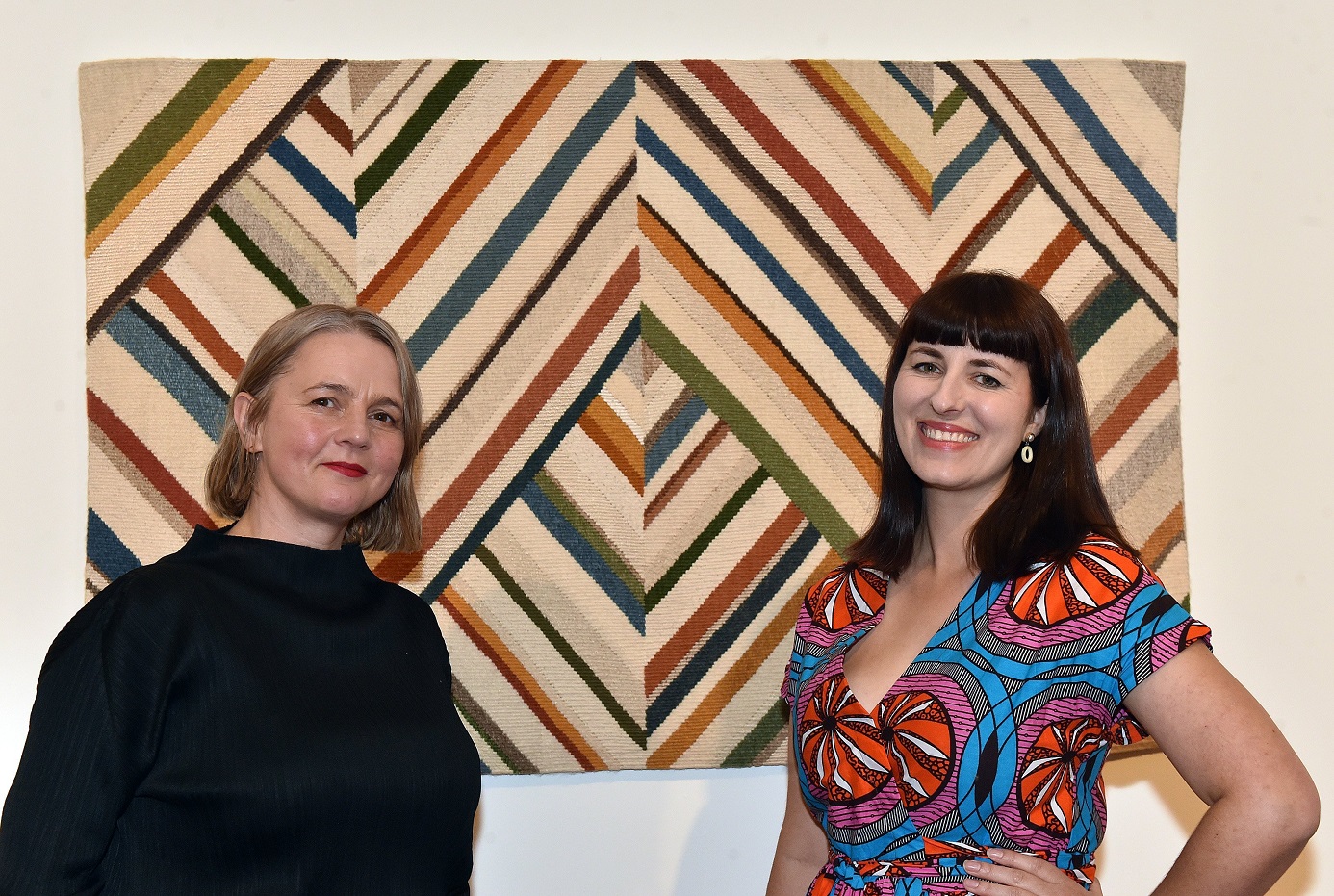
Rebecca Fox talked to the pair about bringing the work of Dunedin artist and textile scholar Margery Blackman to the fore for a new generation.
Margery Blackman’s legacy is of special significance at a local and national level not only because of her "marvellous" tapestry works but also because of her scholarship, community education, exhibitions and advocacy for the craft sector.
It is this "rich and complex" picture of an artist that curators Elle Loui August and Jane Groufsky hope they have brought to life in a new exhibition of Blackman’s work and life.
"That it reflects upon not only the importance of Margery’s work art historically, but her story offers us an opportunity to draw attention to the complex contributions that artists make to our communities. Which is something that is not often acknowledged," August says.
Blackman, who bought a loom and taught herself weaving and tapestry in the 1960s, went on to become honorary curator of ethnographic textiles at Otago Museum, curating exhibitions featuring Māori and Chinese textiles among others, worked on textile conservation at Olveston and wrote a book about its owner, Dorothy Theomin, and made important contributions to research on Māori tāniko weaving.
"The threads of her practice extend out across the world and she was the little shuttle moving through, busily working away weaving them all together" August says.
She also continued her own practice creating many of her own works including the Otago Banners hung at the entrance to Dunedin Hospital, which were commissioned in the early 1980s and completed in 1986.
It is those banners August, who grew up in Dunedin, remembers from her childhood, but it was Blackman’s exhibition at Brett McDowell Gallery in 2010 that left a lasting impression on her.
"Because of the clarity and precision of her work."
As a curator and researcher herself with an interest in art-making from 1978 to 1999, it resonated and stuck with her over the years.
Now working independently she has been able to look strategically at the period and see what stories might benefit from being "lifted up to the surface for people to see more clearly".
"A lot of incredible art-making happened in New Zealand in the 1980s. It was a very fertile time for both studio craft and visual art. Because we’re now in 2024, some of those stories are less present to us. So it’s great to be able to bring a show like this into being because it allows a return to what is a familiar time to some, new to others, and invites a fresh approach to thinking about our shared art historical and cultural past."
As Blackman was such an important person in the craft sector, she felt there needed to be an exhibition that celebrated more than just her work but also her contributions to the community.
"Her story needed a very different approach that could account for the richness of her life’s contributions. What an amazing woman."
So she approached Groufsky, curator social history and the co-curator of "Tāmaki Herenga Waka: Stories of Auckland", who has a love of textiles, suggesting they put together an exhibition on Blackman.

"This in particular stands out in the sense that in the kind of fertile ’60s, ’70s, ’80s period of studio weaving, there are relatively few people doing what Margery does, which is tapestry weaving."
In general Blackman’s tapestry forms have a "freshness and timelessness" which come from her unique approach which is grounded in modernism.
"They have stood the test of time as she used chemical dyes which have been quite stable as opposed to the natural dyes many used at that time."
A fan of Blackman’s work, Groufsky was more than happy to get on board. While the Covid pandemic slowed things down, they were able to meet Blackman, who is now 94, and her husband Gary Blackman, before he died, in 2021 at their Māori Hill home.
"Her practice was so embedded in the space. It was lovely to see the rug hanging over banister and now see it on a plinth mimicking how it first started," Groufsky says.
With only a few exceptions her work is very connected to Dunedin yet also fits into the international modernist textiles of the 20th century.
"It’s fantastic her work will be better understood throughout the country as a result of this exhibition"
It was also "amazing to experience the famous Blackman hospitality". The pair expected to chat to them for a few hours, instead emerging nearly eight hours later.
"It’s one thing to study someone, it’s another to experience it first hand and their family has been so supportive and helpful," Groufsky says.
August says Blackman is quietly pleased by the idea of the exhibition but is always extremely modest about her achievements, saying there were always others involved.
But there was not a lot that Blackman was not involved in, the curators discovered.
"She was on the Crafts Council. She was in the Spinners and Weavers Guild, the Friends of Otago Museum, involved in projects at Toitū Otago Settlers Museum, Hocken Collections, Olveston ... She was so busy, teaching and mentoring people one on one and just as passionately pursuing her own development as an artist."
Blackman also had an ambition for the sector as a whole to flourish and grow. She was committed to high standards and wanted people in the sector to raise the level and precision of their practice and to excel.
"A lot of her advocacy work in the crafts sector at the time was really dedicated to bringing out the best for other artists as well."

August says craft has been under-thought in New Zealand.
"Craft is often most closely associated with notions of skill, so it is not often understood as having an intellectual dimension. Margery’s story and her work completely overturns that assumption. I felt that so passionately when the tapestry From Aramoana was being hung on the wall. It seemed undeniable for both of us that this is a major artwork of its time.
"It’s an important artwork for Dunedin especially because of the complexity of its themes, the way these are expressed in form, and because of the events of the era that it is responding to."
Groufsky says that is why the exhibition has such a strong social historical focus.
"It’s not simply her work, but it’s her works contextualised within that moment in those communities, which is why we have works by her husband, Gary; we have lots of ephemera."
She also feels this exhibition is an important marker in the push for textiles to be recognised as an art form.
"I optimistically feel like we’re maybe cresting the hill — I mean, the Mataaho Collective won the [Golden Lion] at Venice Biennale with a woven work. You really can’t make more of a case than that.
"So it’s, it’s very energising to feel like you’re contributing to part of that. When people are talking about textile shows, often you do feel like you’re on the back foot. But I want to get to a point where that’s not even part of the conversation."
Blackman gave her own significant collection of textiles to Tuhura Otago Museum two years ago, which were exhibited by the museum.
It highlighted how she sought to add to the museum’s collection using her knowledge as a maker.
"So she wasn’t necessarily buying something because it maybe looked pretty on a wall. She was drawn to the techniques and the skill of the maker and a story it would tell. She fed that back and to the community through her own research and publication."
For August and Groufsky, who worked on the exhibition from different ends of the country — August in Dunedin with the archives held by the family and other city institutions and Groufsky in Auckland with the spinners and weavers archive — there have been a few surprises along the way.
For August it was the connections the Blackmans made with the "luminaries of mid-century textiles" the world over such as Anni Albers (1899-1994), Jack Lenor Larsen, Kaffe Fassett and Peter Collingwood. The latter two the Blackman and Milner families hosted here in their homes in Dunedin.
They have organised the exhibition into three sections. The first looks at Blackman’s early work and home.

The second showcases Blackman’s work and the third is a reflection on her contributions to the community and the textiles she collected.
They hope people will learn more and understood more about weaving as a result of the exhibition.
"An exhibition like this is a fabulous opportunity for people to encounter the cultural DNA of textiles practice."
While Blackman is an important part of the story, her story also touches on the stories of lots of important artists.
"She’s touched many people. She’s inspired many people she’s learned from and learned with many, many people. She’s taught us a lot by studying her for four years."
Those who worked with Blackman over the years have also had a chance to acknowledge her contribution during a series of presentations and talks at the gallery last weekend.
University of Auckland museums and cultural heritage associate professor Linda Tyler, the former Hocken curator of pictorial collections (1998-2006), worked with Blackman on two of her very many research projects.
"Margery was a joy to work with. Her scholarly attention to detail was remarkable, as was her retentive memory. She enriched our understanding of women’s contribution to culture in Dunedin, particularly the networks that existed in the 19th and early 20th century between women artists who were interested craft and in the natural world."
She worked tirelessly as a researcher and documenter to shed light on neglected and overlooked part of our history.
"A gifted story teller, she was able to offer guided tours of exhibits or talk to the public about aspects of collections, and she has a wealth of knowledge of weaving in Aotearoa which is unmatched."
Dr Patricia Te Arapo Wallace (Ngāti Porou), senior adjunct fellow at Aotahi School of Māori, who was a contributing author, alongside Blackman, to the book Whatu Kākahu: Māori Cloaks, edited by Awhina Tamarapa, said Blackman had already been been publishing her research on Māori cloaks while in her honorary role at Otago Museum in mid-1980s.
She inspired others in their research and generously shared her knowledge, which was highly respected in the Māori weaving community, leading to her being invited to write a chapter for the book.
Moira White, humanities curator at Tūhura Otago Museum, and Dr Jane Malthus, former clothing and textile sciences and design academic and dress historian and curator also spoke of her contributions to the museum and community.
TO SEE
"Margery Blackman: Weaving, Life," Dunedin Public Art Gallery, until October 13.












